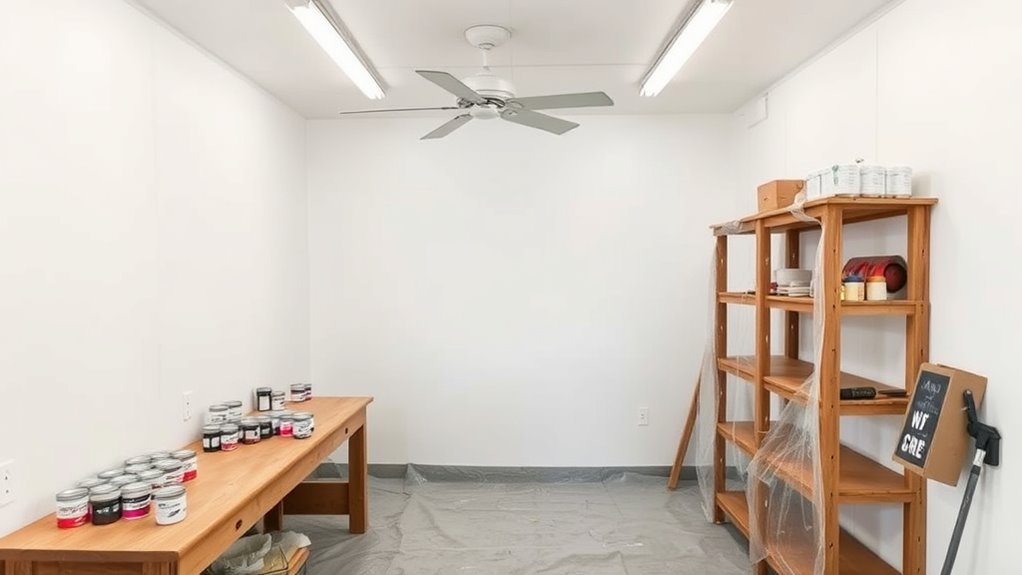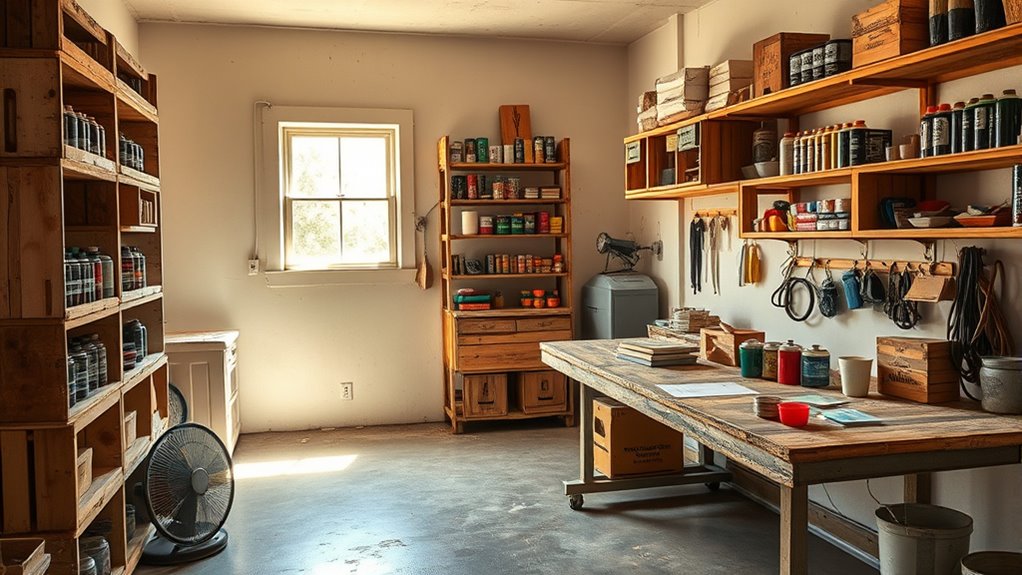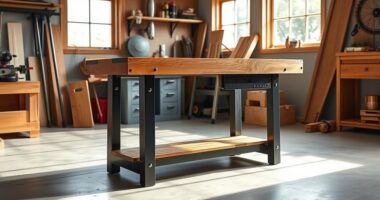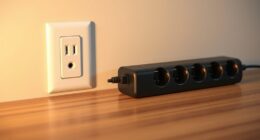To create a safe finishing room on a shoestring budget, focus on improving ventilation and odor control. Use affordable fans, like box fans or window exhaust fans, and position them near work areas to direct fumes outside. Seal off the space with plastic barriers and use household items like baking soda or activated charcoal to absorb odors. Regularly ventilate during and after projects to keep air clean. Keep exploring for more budget-friendly tips to make your workspace safer.
Key Takeaways
- Install window exhaust fans or DIY air filtration systems near work areas to improve airflow cost-effectively.
- Use water-based, low-odor finishes and seal off rooms with plastic barriers to contain fumes.
- Incorporate household items like baking soda and activated charcoal to naturally absorb odors.
- Strategically position fans to direct fumes outside and maximize ventilation efficiency.
- Regularly clean the workspace and store chemicals in sealed containers to reduce airborne contaminants.

Setting up a safe finishing room doesn’t have to break the bank. With some strategic planning, you can create a workspace that’s both cost-effective and safe for you and your environment. One of the most important aspects to focus on is ventilation improvements. Proper airflow is essential for dispersing harmful fumes and reducing airborne particles that can pose health risks. You don’t need expensive industrial systems—simple solutions like installing a window exhaust fan or creating a DIY air filtration system can make a big difference. Positioning your exhaust fan near your work area helps pull fumes away from you and direct them outside, preventing buildup inside your finishing room. Additionally, using box fans with activated charcoal filters can help improve air quality without the high costs of commercial filtration units. Incorporating automation in your ventilation setup, such as timers or switches, can ensure consistent airflow and enhance safety.
Create a safe finishing space with budget-friendly ventilation and odor control solutions.
Odor control techniques are equally necessary. Strong fumes from paints, stains, and solvents can linger and create an uncomfortable environment. To combat this, start by selecting low-odor or odorless finishes whenever possible. Using water-based products instead of solvent-based ones can greatly reduce offensive smells and VOC emissions. If you already have to work with stronger odors, try sealing off your finishing room with plastic sheeting or temporary barriers to contain fumes. Incorporate household items like baking soda or activated charcoal in the room to absorb odors naturally and inexpensively. Placing bowls of these substances near your work area can help keep the air fresher. Also, make sure good ventilation during and after finishing to quickly clear out any lingering smells. Opening windows, turning on fans, and running exhaust systems for a period after work can dramatically improve air quality.
You should also consider the layout of your finishing room to maximize safety and odor control. Keep your workspace well-ventilated by positioning fans strategically and ensuring that fumes are directed outside. Use drop cloths and plastic barriers to contain dust and overspray, which can contribute to poor air quality if left airborne. Regularly cleaning your work area prevents buildup of dust and residues that can trap fumes and odors. Furthermore, storing chemicals and finishes in sealed containers reduces their vapor release into your workspace. Staying informed about AI in Education and other technological developments can also inspire innovative safety solutions and efficiency upgrades for your workspace.
Creating a safe finishing room on a shoestring budget is all about resourcefulness and paying attention to airflow and odors. Small changes like improving ventilation with affordable fans and using simple odor control techniques can make your workspace safer and more comfortable. You don’t need fancy equipment—just a thoughtful approach and some DIY solutions to ensure your finishing room is both budget-friendly and safe.
Frequently Asked Questions
What Are the Best Low-Cost Ventilation Options for a Finishing Room?
When considering low-cost ventilation options, exhaust fans are your best bet for removing fumes and maintaining airflow. You can find affordable models that fit tight budgets and install them easily. Pair these with air purifiers to improve air quality further, especially if ventilation is limited. Both options are cost-effective, simple to set up, and help keep your finishing room safe by controlling airborne particles and fumes efficiently.
How Can I Ensure Proper Airflow Without Expensive Equipment?
Imagine you’re back in the days of the Wright brothers, tinkering with airflow. To guarantee proper airflow without costly equipment, focus on simple ventilation design tricks like using exhaust fans and placing windows strategically for cross-ventilation. Enhance airflow management by opening doors and windows during work, and consider DIY solutions like attaching vents or creating passive airflow channels. These methods keep your finishing room safe and well-ventilated without breaking the bank.
Are There Affordable Alternatives to Commercial Respirators?
You’re wondering if there are affordable respirator alternatives. DIY masks can provide basic protection when crafted from household materials like HEPA filters or multiple layers of tightly woven fabric. While they aren’t as effective as commercial respirators, they’re a cost-effective option for short-term or low-risk tasks. Always verify a good seal and replace filters regularly. These respirator alternatives help improve safety without breaking the bank.
What DIY Solutions Can Improve Safety in a Finishing Space?
To improve safety in your finishing space, consider building a DIY paint booth using plastic sheeting and a frame to contain fumes and overspray. Guarantee proper ventilation with exhaust fans or box fans, and use fire safety measures like keeping flammable materials away from heat sources. Regularly inspect your setup for leaks or hazards, and install smoke detectors to enhance fire safety. These steps help create a safer environment without breaking the bank.
How Can I Prevent Dust Contamination on a Tight Budget?
To prevent dust contamination on a tight budget, focus on improving your paint booth’s dust filtration system. You can make DIY filters using affordable materials like furnace filters or fine mesh screens, and place them at entry points or vents. Regularly clean or replace these filters, and create a sealed environment by covering gaps with plastic sheeting. These simple steps keep dust out and guarantee a cleaner, safer finishing space.
Conclusion
With a little creativity and resourcefulness, you can transform your finishing room into a safe haven without breaking the bank. Think of it as planting a sturdy tree—nurturing safety and protection from the roots up. By repurposing materials and implementing simple precautions, you’re building a fortress that shields your workspace like a protective canopy. Remember, safety doesn’t have to be costly; it’s about cultivating an environment where your craft can flourish safely and confidently.









